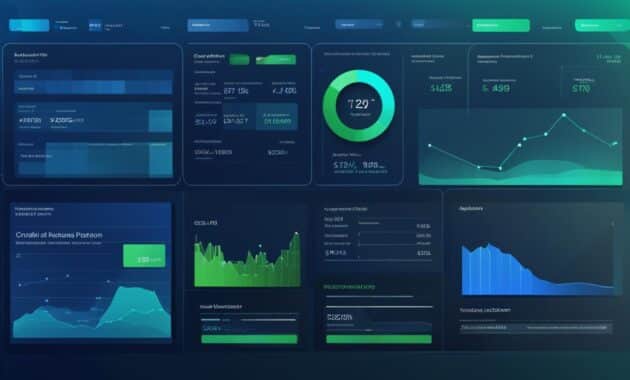As consumers increasingly rely on credit cards for their everyday purchases, credit card issuers play a crucial role in ensuring secure and convenient payment options. One such tool that empowers credit card issuers is the Visa Analytics Platform. This web-based analytics solution provides detailed payments data and valuable insights to help issuers make informed business decisions.
With the Visa Analytics Platform, executives, managers, and data analysts can gain actionable intelligence on a range of key areas such as cardholder behavior, portfolio performance, fraud mitigation, merchant performance, and risk management. The platform offers powerful peer benchmarking, easy-to-understand dashboards, and customizable reports, all geared towards improving business strategies and enhancing customer experiences.
Key Takeaways:
- The Visa Analytics Platform provides credit card issuers with detailed payments data and insights.
- It helps executives, managers, and data analysts make informed business decisions.
- The platform offers peer benchmarking, dashboards, and customizable reports.
- Credit card issuers can gain actionable intelligence on cardholder behavior, portfolio performance, fraud mitigation, merchant performance, and risk management.
- The Visa Analytics Platform enhances business strategies and boosts customer experiences.
The Role of Credit Cards in Consumer Finances
Credit cards have become an integral part of consumer finances, offering a convenient method of payment without the need for upfront cash. Since their introduction in the late 1950s, credit cards have revolutionized the way we shop and manage our expenses.
However, it’s important to note that credit card usage can contribute to rising consumer credit card debt, particularly during periods of economic uncertainty. In recent years, the credit card industry has faced various challenges, including high inflation, regulatory pressures, and shifting consumer spending habits.
Different generations have different attitudes towards credit cards. For example, Gen Zers are increasingly adopting credit cards, but they are also carrying significant credit card debt. This trend reflects both the convenience and potential pitfalls associated with credit card usage.
US household credit card debt has reached record levels, posing challenges for many individuals struggling to repay their balances. This increasing debt burden has prompted credit card companies to explore innovative solutions and adapt to changing consumer expectations.
Credit card issuers are ramping up their digital advertising efforts to attract cost-conscious consumers. They are also implementing new strategies, such as buy now, pay later options and digital wallets, to provide more flexible payment alternatives.
Consumer Debt and Credit Scores
One crucial aspect of credit cards is their impact on consumer credit scores. Credit card usage directly influences credit scores and plays a significant role in determining an individual’s creditworthiness. Responsible credit card usage, including timely payments and maintaining a low credit utilization ratio, can positively impact credit scores.
However, excessive credit card debt can have detrimental effects on credit scores, making it challenging for individuals to access favorable interest rates or obtain new lines of credit. Therefore, it is crucial for consumers to carefully manage their credit card balances and payment obligations to maintain healthy credit scores.
Enhanced Spending Power and Credit Limits
Credit cards provide consumers with enhanced spending power by offering access to a credit limit, which determines the maximum amount of credit a cardholder can utilize. A higher credit limit allows individuals to make larger purchases and manage unexpected expenses.
However, credit limits are not unlimited, and they are determined by credit card companies based on various factors, including an individual’s credit history, income, and payment behavior. Cardholders must use their credit limit responsibly to avoid exceeding their repayment capacity and falling into debt.
Changing Landscape and Financial Needs
The credit card industry is continually evolving to meet the changing financial needs of consumers. With the emergence of new payment technologies and increased online shopping, credit card companies are adapting their offerings to remain competitive.
Table: Credit Card Industry Trends
| Trends | Impact |
|---|---|
| Increasing digital advertising budgets | Attracting cost-conscious consumers |
| Introduction of buy now, pay later options | Providing flexible payment alternatives |
| Rise of digital wallets | Facilitating secure and convenient online transactions |
As the credit card industry evolves, it is essential for consumers to stay informed about the latest trends and emerging payment options to make informed financial decisions.
With a deep understanding of credit cards’ role in consumer finances, individuals can navigate the opportunities and challenges associated with credit card usage effectively.
Financial Benefits and Control with Visa Consumer Controls

Visa Consumer Controls provide a range of financial benefits and advanced controls that empower consumers to take charge of their credit card accounts. With personalized account alerts and customizable controls, cardholders can effectively manage their finances and make informed decisions.
One of the key features of Visa Consumer Controls is the ability to set personalized account alerts. These alerts can be customized based on individual preferences and financial goals. Whether it’s tracking spending limits, monitoring transaction activities, or receiving notifications for due dates, cardholders can stay on top of their finances with ease.
Additionally, Visa Consumer Controls offer advanced controls that enhance financial management and security. One such feature is the generation of unique virtual card numbers. These virtual card numbers can be used for online purchases, providing an extra layer of security by keeping the actual card number hidden.
By utilizing Visa Consumer Controls, consumers can manage their household spending effectively. The advanced controls allow them to set limits on expenses, ensuring that their financial goals are met. Whether it’s controlling online spending or limiting expenses in specific categories, consumers have the power to make informed decisions about their financial well-being.
Moreover, Visa Consumer Controls address the increasing demand for online spending control. With the rise in digital transactions, consumers are looking for ways to safeguard their financial information and protect themselves from fraudulent activities. The advanced security features offered by Visa Consumer Controls provide peace of mind and help mitigate financial risks.
In summary, Visa Consumer Controls empower consumers with greater financial management and control. With personalized account alerts, advanced controls, and enhanced security features, cardholders can make informed decisions, safeguard their finances, and stay in control of their credit card accounts.
The Digital Transformation of Credit Cards

The credit card industry has undergone a significant digital transformation, revolutionizing the way consumers make payments. With advancements in technology, credit cards have evolved from the traditional cardboard format to plastic, and now embrace the era of digital payments.
The adoption of chip-enabled and contactless payments has provided consumers with greater convenience and security. Contactless payments, in particular, have gained popularity due to their ease of use and reduced physical contact, making transactions faster and more hygienic.
This digital transformation has played a pivotal role in the growth of ecommerce. Consumers now rely heavily on credit and debit cards for their online purchases, leveraging the convenience and security offered by these payment methods.
According to recent statistics, ecommerce sales in the United States reached $791.7 billion in 2020, a significant increase from $601.65 billion in 2019.
In addition to traditional credit cards, the emergence of digital wallets has further revolutionized the industry. Digital wallets like Apple Pay and Google Pay have enabled users to digitize their credit cards, providing a seamless and secure way to make transactions both online and in-store.
| Digital Payment Method | Features and Benefits |
|---|---|
| Contactless Payments | Allows for quick and secure transactions without physical contact |
| Ecommerce | Enables consumers to make online purchases conveniently and securely |
| Digital Wallets | Digitizes credit cards for seamless and secure transactions both online and in-store |
Looking ahead, the use of digital wallets and contactless payments is expected to continue growing. Proximity mobile payments, including contactless payments, are projected to be made by nearly 40% of the US population, with consumers estimated to spend a staggering $687.74 billion via mobile payments in 2024.
This image depicts the seamless and secure nature of digital payments, showcasing the convenience and ease of use that credit cards have achieved through their digital transformation.
Credit Card Industry Trends and Usage

The credit card industry is constantly influenced by various trends and factors that shape its growth and usage. From high inflation to regulatory pressures and changing consumer behaviors, these trends have a significant impact on the industry’s dynamics. Let’s take a closer look at some of these trends and explore how they affect credit card usage and debt.
Changing Consumer Behavior and Credit Card Adoption
Different generations have varying perspectives when it comes to credit card usage. The younger generation, particularly Gen Zers, are increasingly adopting credit cards as a convenient payment method. However, along with their growing adoption, they also tend to carry credit card debt. This trend highlights the importance of financial education and responsible credit card usage among young cardholders.
Credit Card Usage and Debt Statistics
Approximately 70% of US adults use credit cards for their daily transactions and financial needs. Despite the convenience they offer, credit cards have contributed to the record-high levels of credit card debt. Many consumers find it challenging to repay their credit card balances, causing a significant financial burden.
To address this issue, credit card issuers are exploring ways to promote responsible credit card usage and reduce debt. They are increasingly allocating their digital advertising budgets to attract cost-conscious consumers and emphasize the value and low cost associated with their credit cards.
Credit Card Usage and Debt Statistics
| Statistic | Percentage |
|---|---|
| Percentage of US adults using credit cards | 70% |
| Credit card debt levels | Record highs |
Note: The statistics mentioned above illustrate the general trends in credit card usage and debt. Actual figures may vary.
“It’s crucial for consumers to understand the importance of responsible credit card usage and the potentially damaging effects of accumulated debt. Building financial literacy and making informed financial decisions are key to achieving a secure financial future.”
The image above visually represents the credit card industry’s trends and usage, highlighting the significant impact these factors have on consumers and the financial market.
The Impact of Regulatory Pressures on Credit Card Issuers

Credit card issuers are currently facing significant regulatory pressures that have the potential to impact their profitability and operations. Regulators are closely scrutinizing various aspects of the credit card industry, including consumer fees, interest rates, and interchange fees. These regulatory measures aim to promote transparency and fairness in the market, fostering healthy competition among primary card issuers.
One of the key areas of focus for regulators is consumer fees. By ensuring that consumers have access to clear and concise information regarding any fees associated with their credit cards, regulators aim to empower them to make informed decisions and easily switch to cards that offer better service or more favorable terms.
Interest rates are another aspect of credit card issuance that regulators are closely monitoring. By setting limitations or guidelines on interest rates, regulators aim to protect consumers from excessive interest charges and prevent predatory lending practices.
Interchange fees, which are the fees charged between banks for each credit card transaction, are also under scrutiny. Regulators are examining these fees to ensure they are fair and reasonable, encouraging healthy competition among card issuers and ultimately benefiting consumers.
Proposed legislation, such as the Credit Card Competition Act, could potentially have a significant impact on the credit card industry. If passed, this legislation could lead to changes in credit card rewards programs and potentially influence the structure of interchange fees. The implications of such legislation are significant, as they could reshape the landscape of the credit card industry and have long-lasting effects on both issuers and consumers.
These regulatory pressures present challenges and potential risks to credit card issuers’ profitability. Issuers must navigate these changing regulations and adapt their business models accordingly to ensure compliance while maintaining their competitive edge. By proactively addressing the concerns raised by regulators and adopting transparent practices, credit card issuers can demonstrate their commitment to consumer protection and build trust among their cardholders.
Despite the challenges posed by regulatory pressures, credit card issuers have the opportunity to turn these challenges into opportunities for innovation and growth. By embracing these evolving regulations and implementing changes that align with the goals of consumer protection, issuers can position themselves as industry leaders and differentiate themselves in a crowded market.
Innovative Solutions for Risk Management with Visa Analytics Platform

Visa Analytics Platform provides credit card issuers with innovative solutions for effective risk management and fraud mitigation. By leveraging advanced data analytics, the platform enables issuers to identify high-risk market segments, track fraudulent cards, and effectively manage disputes, leading to better operational efficiency and improved customer experience.
Risk Management and Fraud Mitigation
The Visa Analytics Platform empowers credit card issuers to proactively identify potential high-risk market segments. By analyzing transaction data and customer behavior patterns, issuers can identify segments that pose higher risks for fraud and implement targeted risk mitigation strategies. This ensures that necessary precautions are in place to protect both the cardholders and the issuer from potential fraudulent activities.
Tracking Fraudulent Cards
The platform allows credit card issuers to effectively track and monitor fraudulent cards through sophisticated fraud detection algorithms. By continuously analyzing transaction data and identifying suspicious patterns, issuers can quickly detect and mitigate fraudulent activity. This proactive approach helps prevent financial losses and maintain the integrity of the credit card ecosystem.
Managing Disputes
With the Visa Analytics Platform, credit card issuers can efficiently manage disputes by market segments. The platform provides comprehensive data and insights that enable issuers to analyze the nature and frequency of disputes and develop effective strategies to address them. This helps streamline the dispute resolution process, minimize customer dissatisfaction, and improve overall customer service.
The Visa Analytics Platform empowers credit card issuers to make data-driven decisions to lower costs, reduce fraud-related losses, and deliver better customer service. By harnessing the power of advanced analytics, issuers can optimize their risk management strategies, enhance operational efficiency, and ensure a secure and trustworthy credit card environment.
Enhancing Portfolio Performance with Visa Analytics Platform

Visa Analytics Platform is a powerful tool that enables credit card issuers to assess and enhance their portfolio performance. By leveraging the platform’s advanced analytics capabilities, issuers can gain valuable insights into their portfolio, identify revenue drivers, monitor interchange amounts, and analyze decline rates.
With Visa Analytics Platform, issuers can delve deep into their portfolio performance across various dimensions such as market segments, merchants, channels, and geography. This comprehensive view allows them to understand the strengths and weaknesses of their portfolio, identify growth opportunities, and make data-driven decisions to drive profitability and customer satisfaction.
Identifying Revenue Drivers
One key feature of Visa Analytics Platform is its ability to help issuers identify revenue drivers within their portfolio. By analyzing transaction data and customer behavior, issuers can gain insights into the products, services, or segments that contribute the most to their revenue. This knowledge allows them to focus their resources and efforts on these high-value areas, ultimately driving portfolio performance.
Monitoring Interchange Amounts
Interchange fees play a crucial role in the revenue generated by credit card issuers. Visa Analytics Platform allows issuers to monitor interchange amounts and analyze the impact on their portfolio performance. By understanding the interchange dynamics, issuers can optimize their pricing strategies, negotiate favorable agreements, and maximize their revenue streams.
Analyzing Decline Rates
Decline rates can significantly impact the overall performance of a credit card portfolio. Visa Analytics Platform provides issuers with the tools to analyze decline rates and investigate the underlying factors behind these declines. By understanding the reasons for decline, issuers can take proactive measures to reduce declines, improve authorization rates, and enhance customer satisfaction.
Utilizing Visa Analytics Platform to enhance portfolio performance empowers credit card issuers to make informed decisions, optimize revenue drivers, monitor interchange amounts, and analyze decline rates. By leveraging these insights, issuers can effectively navigate the competitive credit card industry and drive profitability while ensuring customer satisfaction.
| Benefits of Enhancing Portfolio Performance | Actions to Take |
|---|---|
| Increased revenue and profitability | Focus on revenue drivers |
| Improved customer satisfaction and loyalty | Analyze and reduce decline rates |
| Optimized pricing strategies | Monitor interchange amounts |
| Identification of growth opportunities | Utilize data-driven insights |
Optimizing Merchant Performance with Visa Analytics Platform

Visa Analytics Platform offers valuable insights to credit card issuers, enabling them to optimize merchant performance and drive business growth. By leveraging the power of data analytics, issuers can make informed decisions to enhance merchant relationships, identify trending merchants, analyze spend behavior, and monitor payment methods.
Identifying Merchants Driving Spend
With Visa Analytics Platform, credit card issuers can identify the merchants that are driving significant spend. By analyzing transaction data, issuers can pinpoint the merchants where cardholders are making the most purchases and allocate resources accordingly. Understanding the merchants that generate the highest transaction volume allows issuers to form strategic partnerships and implement targeted marketing initiatives to drive even more spend.
Analyzing Trending Merchants
The platform also enables issuers to monitor the performance of individual merchants over time. By tracking trends and analyzing historical data, issuers can identify merchants that may be experiencing a decline in customer transactions or overall performance. This information empowers issuers to take proactive measures to support struggling merchants, explore opportunities for improvement, and strengthen relationships.
Examining Spend Behavior
Visa Analytics Platform provides credit card issuers with detailed insights into cardholder spend behavior. By analyzing data such as transaction amounts, frequency, and categories, issuers can gain a deep understanding of how cardholders are using their credit cards. This valuable information allows issuers to uncover patterns, identify emerging trends, and develop targeted campaigns to drive specific types of spend.
Monitoring Payment Methods
Understanding the payment methods used by cardholders is crucial for credit card issuers. Visa Analytics Platform enables issuers to monitor the popularity of different payment methods, such as contactless payments, digital wallets, or traditional card-based transactions. This information helps issuers tailor their services and offerings to align with evolving customer preferences and drive higher engagement.
By leveraging these powerful insights from Visa Analytics Platform, credit card issuers can optimize their merchant performance, enhance customer satisfaction, and drive overall business growth. With a deep understanding of spend behavior, trending merchants, and payment methods, issuers can develop targeted strategies that bring value to both their merchant partners and cardholders.
Increasing Cardholder Engagement with Visa Analytics Platform
Visa Analytics Platform provides credit card issuers with valuable insights to increase cardholder engagement and drive overall satisfaction. By analyzing cardholder behavior, tracking spending patterns, and focusing on activating and retaining cards, issuers can tailor their strategies to enhance card usage, increase loyalty, and improve the overall experience for their customers.
Understanding cardholder behavior is key to identifying opportunities for engagement. By analyzing spending patterns, issuers can gain insights into the preferences and needs of their cardholders. This information can guide issuers in developing targeted communication strategies and personalized offerings that align with the interests of their customers. From customized rewards programs to exclusive discounts and promotions, issuers can increase card usage by providing incentives that resonate with their cardholders’ spending habits and preferences.
Driving early card activation is another important aspect of increasing engagement. By implementing proactive activation campaigns and leveraging the data provided by the Visa Analytics Platform, issuers can encourage new cardholders to activate their cards and start using them. Activated cards not only contribute to increased card usage but also establish the foundation for an ongoing and mutually beneficial relationship between issuers and cardholders.
“Understanding cardholder behavior and preferences is the key to increasing card usage and driving engagement. With Visa Analytics Platform, issuers can harness the power of data to create personalized experiences and offerings that resonate with their cardholders.”
In addition to analyzing cardholder behavior and driving card activation, the Visa Analytics Platform enables issuers to closely monitor spending patterns. By analyzing spending data, issuers can identify key trends, such as popular merchants or categories, and optimize their offerings accordingly. This data-driven approach allows issuers to develop targeted marketing campaigns, offer relevant rewards and benefits, and enhance the overall value proposition of their cards. By analyzing spending patterns, issuers can also identify potential opportunities for cross-selling and upselling, further increasing card usage and engagement.
Case Study: Increasing Card Usage with Personalized Rewards
A major credit card issuer, XYZ Bank, leveraged the insights provided by the Visa Analytics Platform to increase card usage and drive engagement among their cardholders. By analyzing spending patterns, XYZ Bank identified that a significant portion of their cardholders were frequent travelers, particularly in the airline and hotel categories.
| Category | 2019 Spending | 2020 Spending | YoY Growth |
|---|---|---|---|
| Airlines | $15,000 | $18,500 | +23.33% |
| Hotels | $12,500 | $14,800 | +18.4% |
Based on this data, XYZ Bank revamped their rewards program to offer enhanced benefits for travel-related expenses. They introduced exclusive airport lounge access, accelerated rewards points for airline and hotel purchases, and personalized travel concierge services. These targeted rewards and benefits not only incentivized cardholders to use their cards for travel-related expenses but also fostered a sense of exclusivity and loyalty among the cardholder base.
As a result of their data-driven approach, XYZ Bank experienced a significant increase in card usage and engagement among their target audience. Cardholders in the airline and hotel categories showed a year-over-year growth in spending, highlighting the effectiveness of the personalized rewards program powered by the Visa Analytics Platform.
By leveraging the power of the Visa Analytics Platform, credit card issuers can gain valuable insights into cardholder behavior, drive card activation, analyze spending patterns, and tailor their offerings to increase card usage and overall engagement. Through data-driven decision-making, issuers can optimize strategies, enhance customer satisfaction, and stay ahead in the competitive credit card industry.
Exploring Data-Driven Business Transformation with Visa Analytics Platform

Visa Analytics Platform empowers credit card issuers to transform their business through data-driven decisions. By leveraging the power of data analytics, issuers can gain valuable insights and make informed business decisions to stay ahead in the competitive credit card industry.
The platform provides access to detailed payments data, enabling issuers to analyze trends, patterns, and customer behavior. This valuable information allows executives, managers, and data analysts to make data-driven decisions at every level of the organization.
With benchmarking capabilities, issuers can compare their performance to industry standards and identify areas for improvement. Customizable reports further help in monitoring key performance indicators and track progress over time.
By using Visa Analytics Platform, issuers can gain actionable insights and intelligence to enhance overall performance, reduce fraud, manage risk, and identify growth opportunities. Armed with this knowledge, issuers can make strategic decisions that align with market trends and customer preferences.
For example, issuers can analyze cardholder behavior to determine the most popular spending categories and develop targeted marketing campaigns to increase card usage. They can also identify high-risk market segments to implement advanced risk management strategies and minimize fraud-related losses.
“Data-driven decisions enable credit card issuers to stay agile and responsive in a rapidly evolving industry. By using data analytics, issuers can make proactive decisions based on actionable insights, rather than relying solely on intuition.”
The use of data analytics not only enhances decision-making capabilities but also improves operational efficiency. By automating data analysis processes, issuers can streamline operations and allocate resources more effectively. This leads to better outcomes and optimized performance.
Visa Analytics Platform is revolutionizing the credit card industry by enabling issuers to unlock the power of data. With actionable insights and robust analytics capabilities, issuers can make informed decisions and drive business success in an increasingly data-centric world.
Key Benefits of Visa Analytics Platform:
- Access to detailed payments data for comprehensive analysis
- Benchmarking capabilities to compare performance with industry standards
- Customizable reports for monitoring key performance indicators
- Actionable insights to enhance overall performance and reduce fraud
- Risk management strategies based on high-risk market segments
- Improved operational efficiency through automated data analysis
With Visa Analytics Platform, credit card issuers can harness the power of data to make smarter decisions, optimize performance, and thrive in a highly competitive industry.
Also Read :Get Your Free Virtual Credit Card Today!
Conclusion
Credit card issuers are invaluable players in the financial industry, providing consumers with convenient and secure payment options. Through their partnership with Visa Analytics Platform, issuers gain access to powerful tools and insights to navigate industry trends, optimize performance, mitigate fraud, and enhance customer relationships. By leveraging data-driven decisions and embracing innovative solutions, credit card issuers can stay competitive, better serve their customers, and drive secure spending in the ever-evolving world of credit cards.
Visa Analytics Platform equips credit card issuers with the means to compare themselves to competitors, gaining valuable credit card industry insights. This allows issuers to understand the market landscape, identify areas for improvement, and benchmark their performance against industry standards. With this knowledge, issuers can make strategic decisions to enhance their products, services, and overall value proposition.
Furthermore, the platform enables credit card issuers to provide secure spending options to their cardholders. By leveraging advanced analytics and fraud mitigation capabilities, issuers can proactively identify and address potential risks, ensuring the safety of cardholder transactions. This not only safeguards the financial well-being of consumers but also enhances the trust and confidence they place in their credit card issuer.
In conclusion, Visa Analytics Platform empowers credit card issuers to thrive in a dynamic industry by harnessing the power of data-driven insights. By leveraging these insights and adopting innovative solutions, credit card issuers can differentiate themselves, meet the evolving needs of their customers, and drive secure spending in an increasingly digital and interconnected world.
FAQs
Q: How do credit card issuers work with credit card networks?
A: Credit card issuers collaborate with credit card networks such as Visa, Mastercard, American Express, and Discover to process transactions, provide cardholder services, and facilitate payments.
Q: What are some of the best credit card offers available?
A: The best credit card offers often include rewards such as cash back, travel points, or airline miles, as well as features like zero annual fees, low introductory APRs, and generous sign-up bonuses.
Q: Can you provide a list of credit card companies that issue credit cards in the U.S.?
A: Some of the major credit card issuers in the U.S. include Chase, Citibank, Bank of America, Capital One, and American Express, among others.
Q: How do credit card issuers ensure secure credit card payment transactions?
A: Credit card issuers employ advanced security measures such as encryption, tokenization, fraud monitoring, and two-factor authentication to protect cardholders’ data and prevent unauthorized transactions.
Q: What is the difference between credit card issuers and credit card networks?
A: While credit card issuers are financial institutions that provide credit cards to consumers and set terms for card usage, credit card networks like Visa and Mastercard operate the payment processing infrastructure that enables transactions between merchants and cardholders.
Q: Do credit card issuers offer credit cards for individuals with bad credit?
A: Yes, some credit card issuers provide credit cards specifically designed for individuals with less-than-perfect credit histories, offering them an opportunity to rebuild their credit scores through responsible card usage.
Q: What are co-branded credit cards, and how do credit card issuers work with partner companies to offer them?
A: Co-branded credit cards are cards issued by credit card issuers in partnership with specific brands or companies, offering cardholders exclusive benefits, rewards, or discounts related to those partnerships.
Source Links
- https://usa.visa.com/partner-with-us/visa-analytics-platform.html
- https://www.insiderintelligence.com/insights/credit-card-networks-payment-list/
- https://www.mastercard.us/en-us/business/issuers/grow-your-business/mastercard-in-control.html